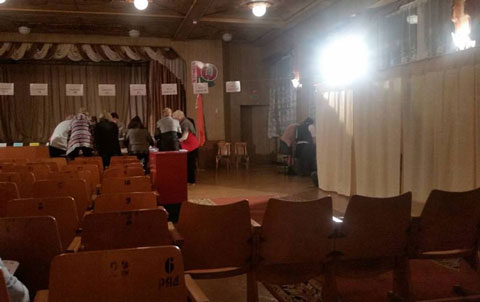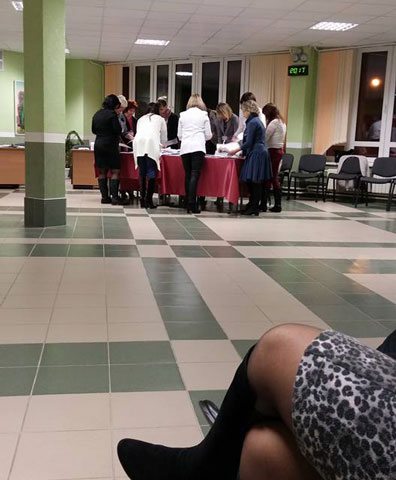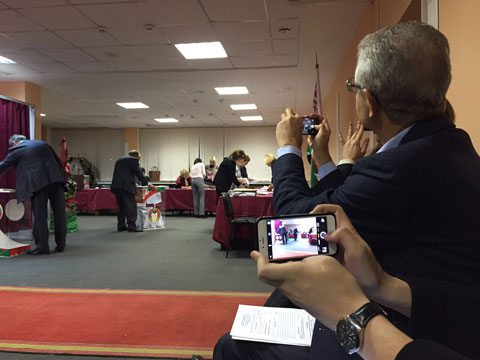Non-transparent calculation of votes is registered in various parts of Belarus
Babrujsk
The overestimation of the turnout by 548 people was registered by observers at polling station No. 69.
“We have been there during the whole day, thoroughly counting the voters, without going away, and counted just 616 people. That's why we were very surprised at seeing 1,164 voters in the final protocol! It means that the commission members increased the turnout to 90% instead of the real one, 65%,” says the independent observer Yauhen Habrelian.
The observer also reported that observers weren't allowed to come close to the tables at which ballots were calculated. Moreover, the commission members blocked the way to their tables by putting rows of chairs in front of themselves.
“Even visually, the number of ballots was smaller than the one they wrote in the protocol. They calculated everything very quickly for just 30 minutes. At the neighbouring polling station No. 70 the discrepancy in the turnout is just 200 people. We immediately wrote complaints about it,” added Mr. Habrelian.
Let us remind that during the early voting dwellers of hostels were massively forced to vote at polling station No. 69.
Salihorsk
Salihorsk observers of the campaigns “Human Rights Defenders for Free Elections” and “Right to Elect” state the absence of positive changes in the process of calculation of votes at polling stations. Like during the previous electoral campaigns, they were unable to see the ballots as they were allowed to observe the procedure only from a large distance. Moreover, the members of the election commission turned their backs on them while counting.
The procedure of counting remained the same. Each member of the commission counted some part of the ballots and then passed them to the secretary. The secretary then passed these piles to the chairperson and then they calculated the final results. It is the longest process, accompanied with the use of calculator, pencil writings on the paper and whispering talks which the observers are unable to hear. One cannot call such counting of votes open and transparent. The observers weren't shown ballots separately, one after another, so that they could visually see for whom each vote was cast.
In the overwhelming majority of cases the calculation of ballots from various boxes was conducted separately, and the results were voiced separately, too. However, the commissions didn't issue observers with any copies of the protocols of voting with the commission seal and their signatures. The protocols weren't posted for public viewing either.
Hlusk
Observer Ihar Kiryn points at the closed character of the counting of votes at polling station No. 2. According to him, members of the PEC surrounded the table at which the ballots were counted and turned their backs to the observers. Therefore, nobody could see anything.
However, when the observer tried to make a remark about it, he was countered by a pro-governmental observer, employee of the ideological department of the Hlusk District Executive Committee Siarhei Silichonak who said that he could see everything. Other pro-governmental observers just kept silent.
According to Mr. Kiryn, even some of the pro-governmental observers were surprised with the results of the voting at polling station No. 2. According to the final protocol, 21 votes were cast for Siarhei Haidukevich, 16 – for Tatsiana Karatkevich, 14 – for Mikalai Ulakhovich, and as many as 1,305 – for the incumbent president, Aliaksandr Lukashenka. The votes cast during the early voting, voting at home and voting on the election day were counted separately.
According to the calculations of Ihar Kiryn, 595 people voted at polling station No. 2 in Hlusk on October 11. According to the data of the commission, about 100 people voted at home. The observer says that at a certain moment the chairman of the commission told the observers to write out the surnames of all elderly people, after which they allegedly went to their addresses. Mr. Kiryn says that at first the list of the persons who appealed for home voting included only about 30 surnames.
In the morning of October 11 polling station No. 2 was visited by international observers from OSCE. They stayed there for about half an hour, watched the procedure of sealing of the ballot box and headed to another polling station.
Minsk
At polling station No. 25 in the Centralny district of Minsk observers, including international ones, could see the calculation of votes only from a large distance. Of course, they weren't able to see the number of the ballots or their content. That's why they couldn't either confirm or disprove the data put in the final protocol of voting.







